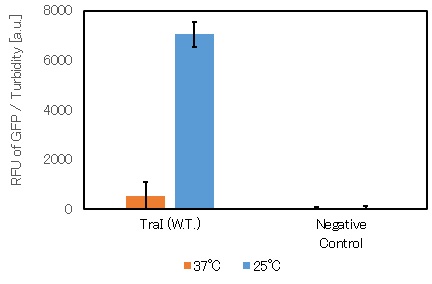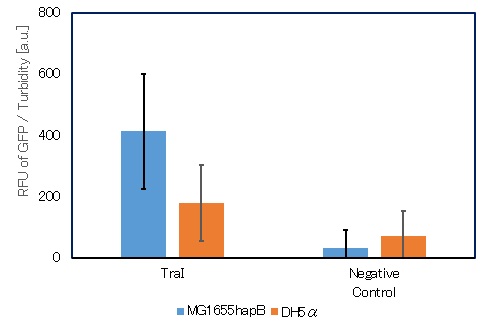Part:BBa_K2505010
Ptet-rbs-traI-tt
Sequence and Features
- 10COMPATIBLE WITH RFC[10]
- 12COMPATIBLE WITH RFC[12]
- 21COMPATIBLE WITH RFC[21]
- 23COMPATIBLE WITH RFC[23]
- 25INCOMPATIBLE WITH RFC[25]Illegal NgoMIV site found at 465
- 1000COMPATIBLE WITH RFC[1000]
The gene traI is derived from Agrobacterium tumefaciens and encode a enzyme necessary for synthesizing Quorum Sensing signaling molecules ([N-]acyl-homoserine lactones, AHLs), 3OC8 HSL (hereafter C8), in E. coli. This part constitutively produces C8.
The DNA sequences of traI (K34G) is optimized for expressing in E. coli considering the codon usage.
Contents
Characterization
Quorum sensing is the cell-to-cell communication system used by a variety of bacteria. traI (Agrobacterium fumigatus) encode the AHL synthases for 3OC8AHL, one of the signal molecules.
we confirmed whether E. coli cells expressing Tral protein produce a practical amount of 3OC8HSL.
To this end, two E. coli strains were constructed; one is the “Sender” strain which produces 3OC8HSL and the other is the “Reporter” strain which expresses GFP in the presence of 3OC8HSL.
To begin with, it was investigated whether the “Reporter” cells could express GFP depending on 3OC8HSL when cultured in liquid LB medium containing various concentrations of 3OC8HSL (0.1 nM -1000 nM).
In the previous similar experiment, the intensities of GFP fluorescence (Relative Fluorescence Units; RFU) have shown to follow Hill's equation [1]. Therfore, in this study, the parameters of Hill's equation were obtained from the data and the concentrations of AHL were calculated from the values of RFU.
Then, whether the “Sender” could produce AHL was investigated. The supernatant of the “Sender” s was added into the actively growing culture of the“Reporter” and the production of AHL was evaluated by observing the expression of GFP.
The following plasmids were introduced into E. coli.
Reporter E.coli
By introducing the plasmids shown in Figure. 1, E. coli cells are expected to produce GFP in response to 3OC8AHL and 3OC6AHL. Note that Ptet is the constitutive promoter. Also, note that LuxR can accept 3OC8AHL as well as the natural ligand, 3OC6AHL ; we here employed LuxR, but not TraR, because LuxR had been characterized far better than TraR in the preceding iGEM projects.
Sender E.coli
We created the Sender by introducing the plasmid of this page.
Construction os TraI gene is shown in Figure. 2
The Sender is expected to produce 3OC8AHL constantly, because the traI gene is placed at downstream of the constitutive promoter, Ptet.
Result
Assay using reagent AHL
In order to analyze the ability of the Reporter to receive AHLs and to express GFP depending on AHL, defined concentrations of reagent AHLs were added to growing culture of the Reporter. It was confirmed that LuxR responded to 3OC8AHL in a similar level to 3OC6HSL. RFU of the Reporter at various AHL concentrations (0.01 nM - 1000 nM) is shown in Fig. 3. Detection limit was over 10nM for both cases.
Hill's equation
Based on the data which is shown in Fig. 4, parameter was obtained to fit Hill’s equation.
Hill’s equation is shown in Eq. 1
Table. 1 The parameter of Hill's equation
The values of parameters are shown in Table. 1
The parameter “a” represents leakiness of the GFP expression in the Receiver. Even in the absence of AHL, it is known that downstream genes below Plux are transcribed slightly. The parameter “b” is the value of RFU when AHL binds to all receptors and is completely induced. The parameter “n“ is the Hill coefficient, and when this value is 1 or more, it is said that there are multiple binding sites. “Km” is the AHL concentration where half of the receptor molecules is bound to the AHL molecules, and this value represent the detection sensitivity of the Reporter. It was found that both AHLs can be detected with a sensitivity of order 10 nM.
Supernatant Assay
To quantify Sender E. coli's 3OC8HSL production, the supernatant of Sender culture was mixed with Reporter culture and RFU was measured after 5 hours of incuvation.
Temperature dependence of AHL production.
During the trial-and-error to increase the productivity of AHL in the Sender, we found that the amount of C8 produced is dependent on the culture temperature of the Sender. RFU was 14 folds larger than DH5α.
3OC8HSL concentration of TraI culture in 37℃ was 34 nM. The RFU values of mixture in which Sender E. coli was cultivated in25℃ exceeded the detection limit.
The result in Fig. 4 shows that temperature dependency of C8 production. This result may reflect that the traI gene is derived from a soil bacterium A. tumefaciens; in nature, the temperature of soil hardly reaches 37 ℃, and the TraI protein may be unstable at 37℃. Indeed, growth of A. tumefaciens occurs optimally at 28°C, and at above 30°C, A. tumefaciens becomes heat-shock state [2].
Strain dependency of 3OC8HSL production
The preceding iGEM study has shown that the amount of AHL produced by the luxI gene highly depends on the host strain; depending on the used strains as the Sender, there was approximatly 100-fold difference in cell number for obtaining the same activation level of the lux promoter [3]. Therefore, we here used the other strain, MG1655hapB, as the Sender.
We found that Amount of C8 production is depend on E. coli’s strain. RFU is 2 folds larger than DH5α.
Calculated from the graph obtained in the reagent assay, 3OC8HSL concentration of DH5α culture was 28nM and MG1655hapB culture was 36nM.
Material and Method
Materials
Strains
Reporter
・DH5α
Sender E.coli
・DH5α
Medium
・LB medium
・LB medium containing antibiotics
Dissolve antibiotics in LB medium (Ampicillin 50μg/mL, Chloramphenicol 34μg/mL, Kanamycin
50μg/mL)
Methods
Assay using reagent AHL
1. Grow the Receiver in LB medium containing appropriate antibiotics for about 15 hours.
2. Dilute the culture to 1/200 with flesh LB medium containing antibiotics
3. Incubate the fresh culture for 2 hours
4. Mix 495 μL of the culture with 5 μL of AHL solution in a microtube (each AHL solution was
dissolved in DMSO and contained 100 microM, 10 microM...of AHL to give a final concentration of
1 microM 100 nM..., respectively)
5. Incubate the microtube for 5 hours with gentle shaking at 37℃
6. Take 100 μL of culture and measure fluorescence intensity (excitation and emission wave lengths
are 495 and 520 nm, respectively) and turbidity (measurement wavelength is 600nm)
7. Calculate RFU dividing fluorescence intensity by turbidity and minus control value.
Supernatant Assay
1. Grow the Sender in LB medium for about 15 hours at each temperature (37℃, 25℃).
2. Harvest the cells by brief centrifugation
3. Perform the same procedure as the reagent assay process (1~4) to prepare Reporter culture.
4. Mix 250 μL of the supernatant of Sender culture with Reporter culture in a microtube.
5. Incubate the microtube for 5 hours with gentle shakingat 37℃
6. Take 100 μL of the culture and measure fluorescence intensity (excitation and emission wave lengths
are 495 and 520 nm, respectively) and turbidity (measurement wavelength is 600 nm)
7. Calculate RFU dividing fluorescence intensity by turbidity and minus control value.
Reference
[1]. http://2014.igem.org/Team:ETH_Zurich/modeling/qs
[2]. Elise R. Morton and Clay Fuqua (2012) UNIT 3D.1 Laboratory Maintenance of Agrobacterium. Curr Protoc Microbiol. 2012 Feb; CHAPTER: Unit3D.1.
[3]. http://2007.igem.org/wiki/index.php/Chiba/Quorum_Sensing
| None |







